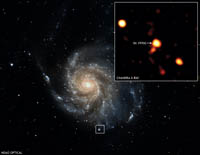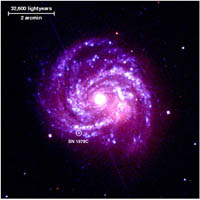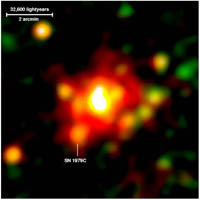Imagine the Universe News - 21 December 2005
Is A Supernova By Any Other Name Still As Sweet?
| 21 December 2005 |

|
|
An optical image of the galaxy M101, with the Chandra image of SN1970G
shown in the inset. The bright cloud in the box in the optical image is not related to the supernova, which is located immediately to the upper right (arrow) of the cloud. (Credit: X-ray: NASA/CXC/GFSC/S.Immler & K.Kuntz; Optical: NOAO/AURA/NSF/G.Jacoby, B.Bohannan & M.Hanna) |
Scientists using NASA's Chandra X-ray Observatory have witnessed a cosmic rite of passage, the transition from a supernova to a supernova remnant, a process that has been poorly defined and never seen in much detail until now.
A supernova is a massive star explosion; the remnant is the beautiful glowing shell that evolves afterwords. When does a supernova become supernova remnant? When does the shell appear and what powers its radiant glow?
A science team led by Dr. Stefan Immler of Universities Space Research Association, working at NASA Goddard Space Flight Center in Greenbelt, Md., has taken a fresh look at a supernova that exploded in 1970, called SN 1970G, just off the handle of the Big Dipper. Although many older supernova remnants (e.g. the Crab nebula) have been observed with X-ray telescopes, SN 1970G is the oldest supernova ever seen by X-ray telescopes.
"Some astronomers have thought there's a moment when the supernova remnant magically turns on years after the supernova itself has faded away, when the shock wave of the explosion finally hits and lights up the interstellar medium," said Immler. "By contrast, our results show that a new supernova quickly and seamlessly evolves into a supernova remnant. The star's own debris, and not the interstellar medium gas, fuels the remnant."
These results appear in The Astrophysical Journal, co-authored by Dr. Kip Kuntz (Univ. of Maryland, Baltimore County). They support previous Chandra observations of SN 1987A by Dr. Sangwook Park of Penn State.
Using new data from Chandra and archived data from the European-led ROSAT and XMM-Newton observatories, Immler and Kuntz pieced together how SN 1970G has evolved over the years. They found telltale signs of a supernova remnant -- material heated by the supernova shock and glowing in X-ray light. But they did not find evidence of interstellar gas, even across a distance around the site of the explosion 35 times larger than our solar system.
Instead, the material which we call the remnant is from the stellar wind of the star itself and not distant gas in the interstellar medium. This wind, comprising energetic ions, was shed by the progenitor star thousands to million of years before the explosion. The interstellar medium would be much denser than this stellar wind.
Immler and Kuntz next studied the density profiles of all other supernovae that have been detected over the past two decades. Sure enough, the low-density circumstellar matter from the stellar wind was the source of X-rays, not the interstellar medium. Immler said that historical supernova remnants such as Cassiopeia A, which exploded some 320 years ago, also show no signs of activity from the interstellar medium.
SN 1970G is located in the galaxy M101, also called the Pinwheel Galaxy, a stunning spiral galaxy about 22 million light years away in the constellation Ursa Major, home of the Big Dipper. Although the galaxy itself in visible from dark skies with binoculars, telescopes cannot resolve much structure in SN 1970G, unlike for supernova remnants in our Milky Way galaxy. Discovered with an optical telescope in 1970, SN 1970G was not seen with X-ray telescopes until the 1990s.
Confirmation of Earlier Work
|
This work confirms and extends earlier work Immler did on another supernova, SN 1979C, located in the M100, a spiral galaxy in Coma Berenices. SN 1979C had puzzled astronomers because its X-ray intensity had remained bright long after it had faded in optical light. Immler's team could identify the history of the star that created SN 1979C through a process analogous to counting rings in a tree trunk. This star, about 18 times more massive than our Sun, produced fierce stellar winds. That material was flung into space for millions of years, creating concentric rings around the star. The X-rays -- produced after the explosion when the supernova shock caught up with the stellar wind and heated it to a temperature of several million degrees -- illuminated 16,000 years' worth of stellar activity. Hence Immler speculates that the abundance of stellar wind has provided ample material to keep SN 1979C glowing so brightly.
More than Just a Game
This is more than just a name game, more than hypothetically changing SN 1970G to SNR 1970G, Immler said. "We have to rethink this notion that a shock wave from the supernova crashes into the interstellar medium to create a supernova remnant," said Immler. "The luminous supernova remnants that we see can be created without the need of a dense interstellar medium. In fact, our study showed that all supernovae detected in X-rays over the past 25 years live in a low-density environment."



